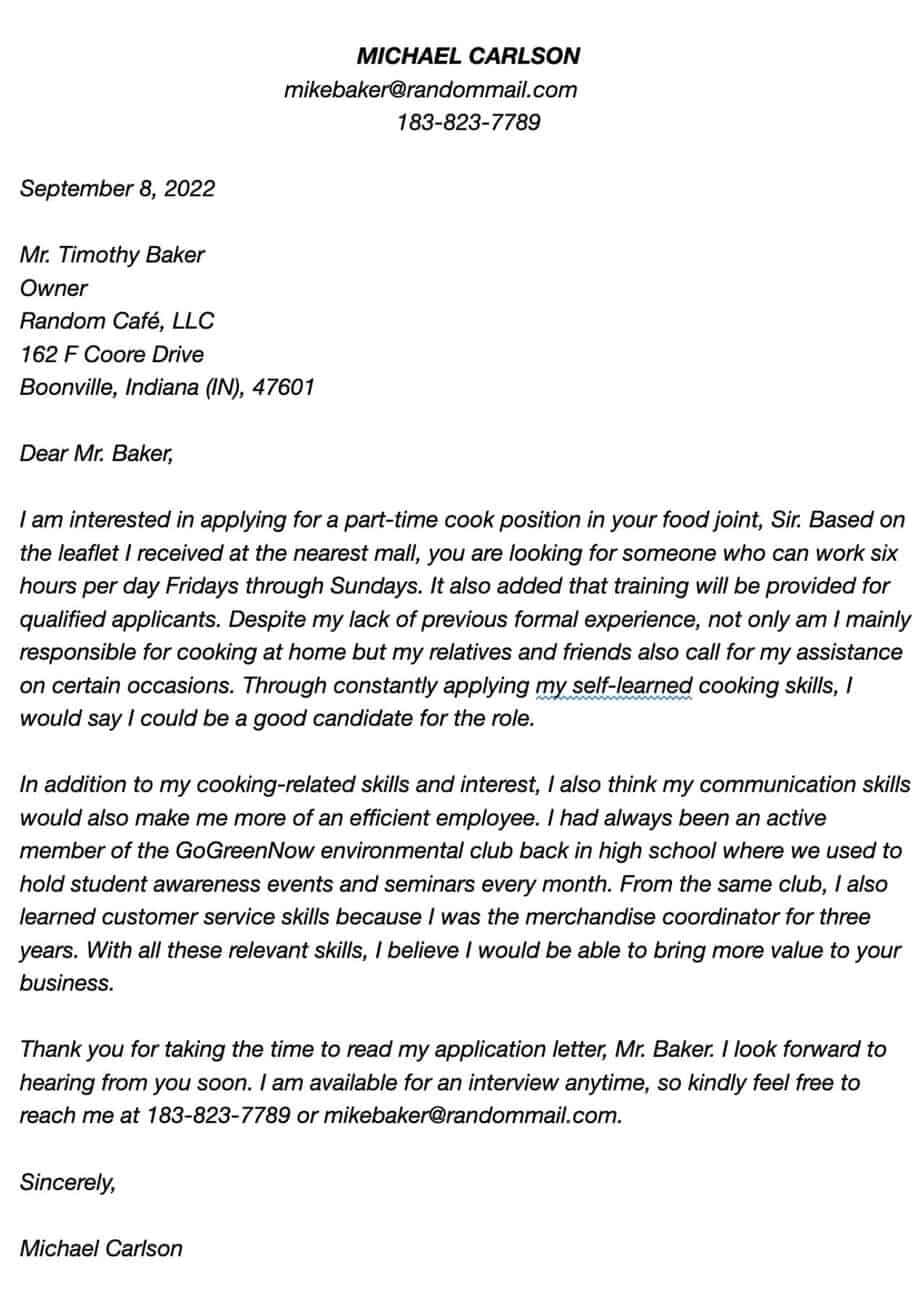Going to school is not an easy task, especially in big cities. The money needed to pay daily expenses, let alone tuition fee, is incredibly high.
This is the main reason why many students seek part-time jobs while studying. But before securing a side gig, students still need to go through job application-related processes.
One of the very first steps in applying for a part-time job is writing a cover letter.
Even if this might seem like a piece of cake for many, first-timers do struggle in doing so.
Luckily enough, we are covering this very issue in our post today. Let’s begin with an overview of the steps to writing a cover letter for a part-time job.
How do we write a cover letter for a part-time job?
To write a cover letter for a part-time job, a heading, a formal greeting or salutation, an introductory paragraph that summarizes the intent, a body that mentions other skills, a closing paragraph with a call-to-action prompt, and a sign-off remark and signature must be included.
Part-time job ideas to consider applying for
We’ve all been there. Writing cover letters may seem like a walk in the park at a glance; in reality, many people find this writing task quite hard.
Applying for a part-time job gets nastier when you have no previous experience. But then again, how can you have any job experience if you don’t start from scratch?
To get your very first part-time job, it is best to avoid being overcritical or selective with the type of job you’re going to apply for.
During the first year in college, for instance, a student is generally allowed to allocate twenty hours per week to work part-time – this could happen either on or off campus.
Popular on-campus positions include being a library staff, tutor, campus guide, and teaching assistant. Meanwhile, there are more options outside the school (if you are applying for one of these positions, have a look at our article “How to write a cover letter for an on-campus job.”)
Food joints, pizzerias, restaurants, cafés, food trucks, sandwich shops, meat shops, bistros, pubs, and bars are some places you can start with.
If you decide to have a part-time job off-campus, you may start drafting your cover letter for a barista position or a cover letter for a waitress position as a default.
These are probably two of the most famous jobs any person can confidently apply for despite having no previous job experience at all.
Your other options include writing a cover letter for a receptionist job or writing a cover letter for a dog handler position and submitting these to establishments around the campus area.
Now that we already have a good grasp of which part-time jobs to consider applying for, let us go over the steps in writing your winning cover letter.
What to put into your part-time job cover letter
The very first things that people seem to struggle with are the pieces of information that should go into the cover letter for a part-time job.
If you happen to read this post in the summertime, you might also want to check out how to write a cover letter for a summer job as a guide.
So, this section aims to elaborate on this for clarity’s sake. So, here’s a list of the things you need to include in your cover letter:
Heading (date, addressee, and company details)
Every cover letter should start with a heading if not with the applicant’s name and contact information at the top of the document.
There are several well-known formats for writing cover letters, but the most important thing to remember is to write the correct and accurate information and avoid mistakes.
Writing your name and contact details can either be done at the topmost part of the document, right before the addressee details in the heading, or in the body – whichever you prefer.
In general, the heading includes the date of writing plus all the necessary details of the company or person you are applying for.
The best practice is to always write to a specific person in your target company and avoid general details; doing so tells your prospective employer that you’ve done your research.
After the date and your addressee’s name, you should write the current position of the person you are writing for.
Then, take a line jump and write the company’s registered business name followed by the complete business address.
Here’s what your heading might look like:
Example (heading):
September 8, 2022
Mr. Timothy Baker
Owner
Random Café, LLC
162 F Coore Drive
Boonville, Indiana (IN), 47601
Greeting or salutation
Then, the greeting comes after the heading, which is also another crucial part of the cover letter because it serves as the very first formal reference to your addressee.
In other words, the greeting is important because it allows you to talk directly to your letter reader for the first time.
Since cover letters are formal documents, it would be best to use suitable greetings as well. That said, vague greetings like “To Whom It May Concern” had better be avoided at all costs.
The use of “Dear Hiring Manager” may be considered adequate because the recommender may not necessarily know the target company or organization.
Avoid casual greetings like “Hi,” “Hey” or “Hello” in your cover letter to make it flawless. These greetings are more suitable in email writing scenarios.
Here are some recommended greetings that you can use in your cover letter:
Examples:
Dear Mr. Clarkson,
Dear Ms. June Hong,
Mr. Furlow,
Mrs. Phillips,
Introductory paragraph
In today’s business setting, being concise with what we want to say suggests politeness toward the message receiver.
This would mean we value the time our message receiver needs to take to read our message. Therefore, we should avoid lengthy cover letters.
The introductory paragraph should clearly state the overall purpose of the letter. At the same time, it should also briefly present what makes the applicant interview-worthy.
Needless to say, you still need to be as detailed as possible in writing the introductory paragraph because this part sets the overall tone of the letter’s content.
A three-to-five-sentence introductory paragraph would be adequate enough – so long as it accurately explains your intent.
If you have already written your name and contact information somewhere before the body, there is no need to repeat these details in the introduction.
To come up with a good introductory paragraph, you must express enthusiasm toward the position, mention relevant references, and shortly elaborate on how you could be a good fit for the position.
Here’s how you can do that:
Example:
Body
After explaining your hard skills, reference, and intent in the introduction, you may now proceed with the body.
The body may now be about relevant soft skills needed in the particular role you are applying for, such as communication, responsibility, and customer service.
If you could back your claim with at least one relevant situation or achievement in the past, which may not necessarily be work-related, it would be better.
Volunteer experiences, community services, or other charity work can also be included in the body. If you have helped in your family business before, feel free to explain such things here.
The body can also be made up of three or five sentences long, just like the introduction. Here’s how you can do that:
Example:
Closing paragraph
Meanwhile, the closing paragraph doesn’t have to be as long as the introduction and body. A two-to-three sentence format would be enough for this part.
The closing paragraph should mainly contain a call-to-action prompt that should help you win that job interview – bear in mind that this is the main goal of your cover letter.
This paragraph can start with a gratitude message followed by a direct reference to your addressee. Remember that mentioning the name of a person creates a warm, personal effect.
Then, express your enthusiasm toward the person’s response to your application. Finally, do not forget to mention your constant availability.
Although a bit repetitive, it would also be nice to mention your contact details again in this part so that your reader wouldn’t have to go back to the top of the document anymore.
Doing this trick is great because your prospective employer may already want to reach out to you after reading your final paragraph.
Here’s how you could structure your closing paragraph:
Example:
Sign-off and signature
Last but not least, sign-off messages are important parts of a cover letter too because they officially mark the end of your entire message.
In other words, the sign-off and signature are textual devices that complete your cover letter. Hence, without them, the letter would be hanging.
Take note that the sign-off message or valediction remark comes before your name or signature. Treat your sign-off remark as the counterpart of your greeting.
Here are some possible sign-offs that you could choose from:
Example:
Sample part-time job cover letter (no experience)

Frequently Asked Questions on “Cover Letter for a Part-time Job”
What part-time jobs are available for college students?
On-campus part-time jobs for college students include research assistant, campus guide, teaching assistant, tutor, and library staff positions. Meanwhile, waiter/waitress, dog handler, receptionist, cashier, and barista are common off-campus.
Should we always write a cover letter for a part-time job?
While not every business owner requires a cover letter, writing one even for a part-time job is recommended. This is because preparing a cover letter would communicate your literacy skills to your prospective employer.
What can I say instead of “I believe” in a cover letter?
Instead of saying “I believe,” it would be best to directly describe your hard or soft skills and then back them up with concrete experiences, relevant achievements, and situations.

Hey fellow Linguaholics! It’s me, Marcel. I am the proud owner of linguaholic.com. Languages have always been my passion and I have studied Linguistics, Computational Linguistics and Sinology at the University of Zurich. It is my utmost pleasure to share with all of you guys what I know about languages and linguistics in general.

